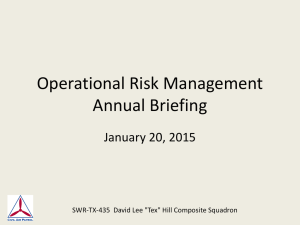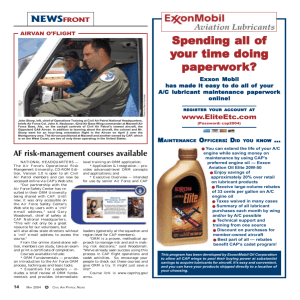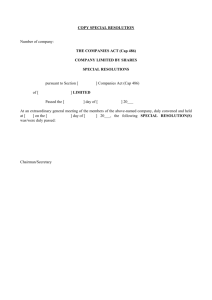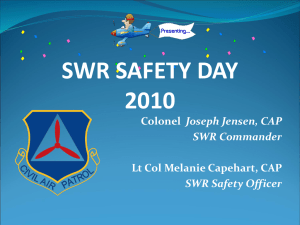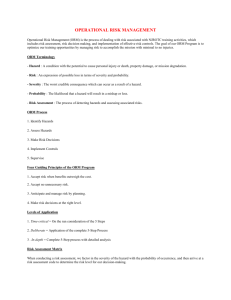Operational Risk Management Annual Briefing
advertisement
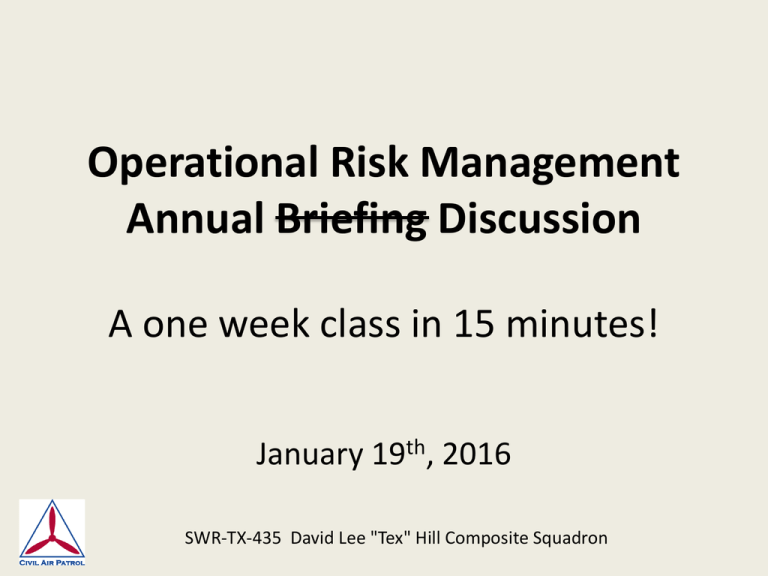
Operational Risk Management Annual Briefing Discussion A one week class in 15 minutes! January 19th, 2016 SWR-TX-435 David Lee "Tex" Hill Composite Squadron CAPR 62-1 CIVIL AIR PATROL SAFETY RESPONSIBILITIES AND PROCEDURES 3d(1): At least once annually, Operational Risk Management (ORM) will be discussed during a unit safety meeting. If anyone asks if you have received your annual ORM “discussion” … the correct answer is “yes, I have”. What the heck is ORM? a methodical, six-step process to “manage” risk “manage” means diminish, limit, or eliminate Why should I care about it? 1. It’s required (while “on duty” at CAP) 2. It’s a good idea (when not “on duty”) 3. It works … it reduces mishaps mishaps = personal injury and damaged property Why do we have to “discuss” it every year? One of the objectives of CAP risk management training … is for YOU to develop enough proficiency in applying the process … so that risk management becomes an automatic part of CAP activities and your personal time. Operational Risk Management NOT exclusive to the Civil Air Patrol Most Federal Agencies All DOD Agencies (USAF, USMC, etc.) Most Fortune 500 Companies Most Industrial Businesses It costs money to implement ORM If it didn’t work, they wouldn’t do it SWR-TX-435 David Lee "Tex" Hill Composite Squadron It’s specifically required for CAP Flying Operations, Ground Teams, and activities BUT You can use the same principles anywhere …you just don’t have any forms to fill out. Without “operational” it’s still “Risk Management” which, is a GOOD idea. Briefly, We will discuss the formal process. Then we’ll talk about the informal process. For Tonight’s Discussion … Assume: You are getting a new “Radio Mission”. Prepare your Tower for antenna mounting. Have it ready immediately. Install appropriate hardware here. So … let’s get that tower ready for the new antenna … but first … we need to “ORM” it (Because it’s a CAP activity). 1. Identify the hazards 2. Assess the risks 3. Analyze the risk control measures 4. Make control decisions 5. Risk control implementation 6. Supervise and review Don’t bother memorizing these steps … just follow the checklist. 1.Identify the hazards … If you don't know the hazards then they can't be controlled. Focus on what is at risk and list potential hazards. Make this a “group effort” Everybody knows something about something Do your best to list every reasonable hazard 1.Identify the hazards … continued The hazards for tonight's discussion? Falling Cuts and scrapes Getting hit by a dropped tool 2. Assess the risks Prioritize the hazards into levels of risk (high, medium, low) Use the Risk Assessment Index (next slide) Falling Frequent: Occurs often, happens many times during a single activity Likely: Occurs regularly, generally happens once per activity Occasional: Occurs infrequently, doesn't occur at every event, but occurs often enough to be considered Seldom: Occurs sporadically, only happens once or twice in an entire CAP career Unlikely: Occurs rarely, often never occurs during an entire CAP career -------------------------------------------------------------------------------------------------------------------------Catastrophic: Complete mission failure, death, or loss of system Critical: Major mission degradation, severe injury, occupational illness, or major system damage Moderate: Minor mission degradation, injury, minor occupational illness, or minor system damage Negligible: Less than minor mission degradation, minor injury, occupational illness, or minor system damage 2. Assess the risks … continued So … which of these three is the “worst” risk? Falling Cuts and scrapes Getting hit by a dropped tool ------------------------------------------------------------------------------------------ The risk of Falling The Risk is rated “High”. The others are “medium” or “low”. Work on “falling” first. 3. Analyze the “risk control” measures A “risk control” must change the risk by decreasing the exposure, severity, or the probability of a mishap. Come up with “actions” that will either reduce or eliminate the risk. Again … better solutions come from a “group effort”. Prioritize these “risk control” measures to get the most “bang for your buck”. 3. Analyze the “risk control” measures … cont. How can we reduce or eliminate the risk of falling? Let’s think of several options. 1. 2. 3. 4. Instead of using a ladder, Erect Scaffolding Use a helicopter Lower the person from above with a rope Use a safety harness and “life line” 4. Make control decisions First, select the best possible risk controls (several of them). Next, decide if those controls will assure that the benefits will outweigh the costs. 1. 2. 3. 4. Instead of using a ladder, Erect Scaffolding Use a helicopter Lower the person from above with a rope Use a safety harness and “life line” 4. Make control decisions … continued So … which is the best “risk control” measure? 1. Instead of using a ladder, Erect Scaffolding Expensive and time consuming 2. Use a helicopter Too expensive, and adds more risk 3. Lower the person from above with a rope Not bad, but might add increased risky tasks For the sake of argument … lets agree A safety harness and “life line” is the best control measure. 5. Risk control implementation Decide how each control will be put into effect EXACTLY how (who, what, when) Who is going to make sure the safety harness is worn correctly Who is going to “double check” Where is the “life line” going to be placed How is it going to get there Who is going to hold the “life line” 6. Supervise and review Watch and see if your “risk controls” were effective. OK … Mission Accomplished. We are ready to receive the new antenna. Nobody got hurt, and nothing was damaged. Remember, CAP has a worksheet for “activities”. It has the “six steps” listed on the back. Risk Management Worksheet Risk Management Worksheet…Page 2 (the instructions on the back) 1. Identify Hazard: those things most likely to have a negative impact on the mission 2. Assess Risk: use the Risk Assessment Matrix 3. Develop Controls: for each hazard to reduce its risk Specify who, what, where, when, and how for each control 4. Determine Mission Risk: From Block 6, identify hazard with highest residual risk Circle the appropriate risk level in Block 8 5. Make Risk Decision: Unit commander will determine authority and level for risk acceptance 6. Implement Controls: Decide how each control will be put into effect Enter in Block 10 7. Supervise: Show how each control will be monitored to ensure proper implementation …Enter in Block 11. 8. Evaluate: After mission is complete, determine effectiveness of each control in reducing the risk of the targeted hazard. 1. Identify the hazards 2. Assess the risks 3. Analyze the risk control measures 4. Make control decisions 5. Risk control implementation 6. Supervise and review For Two Specific Activities: Flying Operations Ground team CAP has specialized ORM Worksheets. ORM Worksheet for Flying Note there are four “No Go” hazards Poor Health or Fatigue Broken Airplane 2 x Bad Weather Note: the higher the risk level the higher the approval authority ORM Worksheet for Ground Team Note similar “hazards” on Flying Checklist: Fatigue Weather Experience Here are the six steps Note: the higher the risk level the higher the approval authority Any questions so far? OK … let’s talk “informal” ORM Which is just deliberate thinking and applying common sense … every day! Informal ORM is usually done while you are at home Or at least when you are not at CAP Which is where you need it the most There is a good chance that unlike CAP activities: No adult supervision Not many to “brainstorm” with Almost unlimited variety of risks and hazards ORM … not just with CAP … but everywhere else too -------------------------------------------------------------------------------------------------------------------------- So what is your “mission” when you aren’t at CAP? Your daily mission (as a minimum … return home) 1. Return home without injury 2. Return home without having damaged any property It’s impossible to do a “risk analysis” for everything in life So…what should get my attention? Jim’s Biggies…extra thinking required! Warning Labels Gasoline Also…from our CAP checklists: Fatigue Bad weather Lack of experience When you are “OFF” the ground If it is dumb, dangerous, or different … Think on it a bit before you begin. Do what you can to reduce the risk. you see “warning labels” attached gasoline is involved (chainsaws, dirt bikes) ladders or scaffolding are involved bad weather (rain is bad weather) a new activity that you are not familiar with a new tool you haven’t used before you are tired or aren’t feeling well Informal Risk Management Always be on the look out for stuff that can hurt you. Do everything you can to minimize the risk of injury. If you can’t reduce the risk of injury … consider walking away. Got it? Your “take home” message 1. Anticipate and manage risk 2. Accept no unnecessary risk Don’t think that just because risk is present, you should avoid the activity. But … reject the risk when total costs outweigh total benefits. In Summary 1. At CAP Activities … use the formal checklist (it’s required) 2. Everywhere else …think and use common sense NOTE: A significant risk is not knowing everything about everything! So make sure you involve others when “thinking” A. YOU are the final “approving authority” B. YOU can always simply choose to say “NO” If it’s “dumb, dangerous, or different” … and you can’t reduce the risk….consider calling it a day! Questions? Did everyone sign the roster? Next Month: “Safety Day” Your Assignment: Think of “risks” associated with The CAP one mile run If you have time, consider reviewing: https://www.capnhq.gov/SafetyEducation/ORM_Basic_Course.pps Probability Frequent Likely Catastrophic S E V Critical E R Moderate I T Negligible y Occasional Seldom Extremely High High Medium Low Unlikely Frequent: Occurs often, happens many times during a single activity Likely: Occurs regularly, generally happens once per activity Occasional: Occurs infrequently, doesn't occur at every event, but occurs often enough to be considered Seldom: Occurs sporadically, only happens once or twice in an entire CAP career Unlikely: Occurs rarely, often never occurs during an entire CAP career Catastrophic: Complete mission failure, death, or loss of system Critical: Major mission degradation, severe injury, occupational illness, or major system damage Moderate: Minor mission degradation, injury, minor occupational illness, or minor system damage Negligible: Less than minor mission degradation, minor injury, occupational illness, or minor system damage So … On Duty … it’s a formal process with forms to fill out and people to notify Everywhere Else … it’s pretty much just deliberate thinking and applying common sense NOTE: A significant risk is not knowing everything about everything! So make sure you involve others when “thinking” and “applying”.
